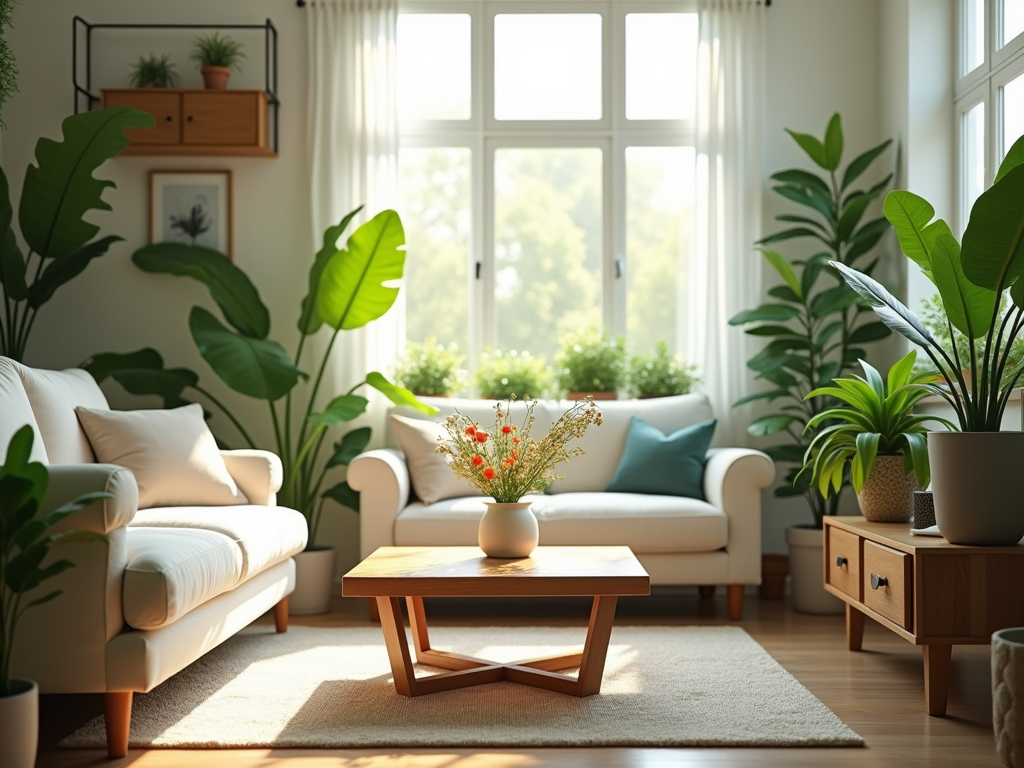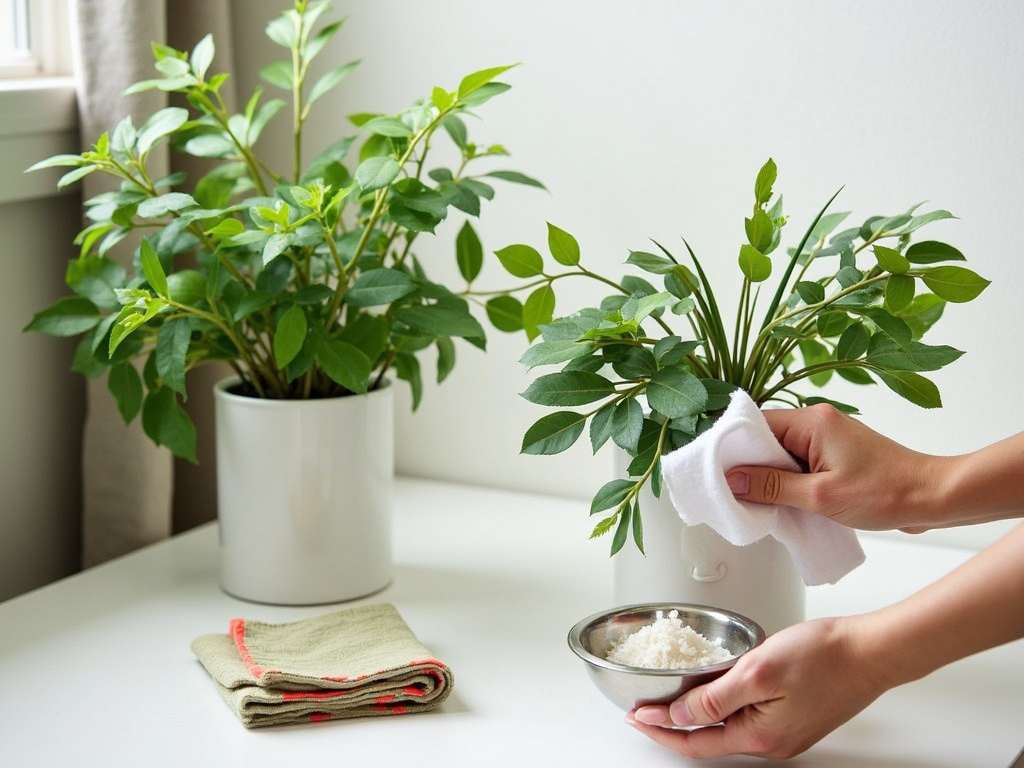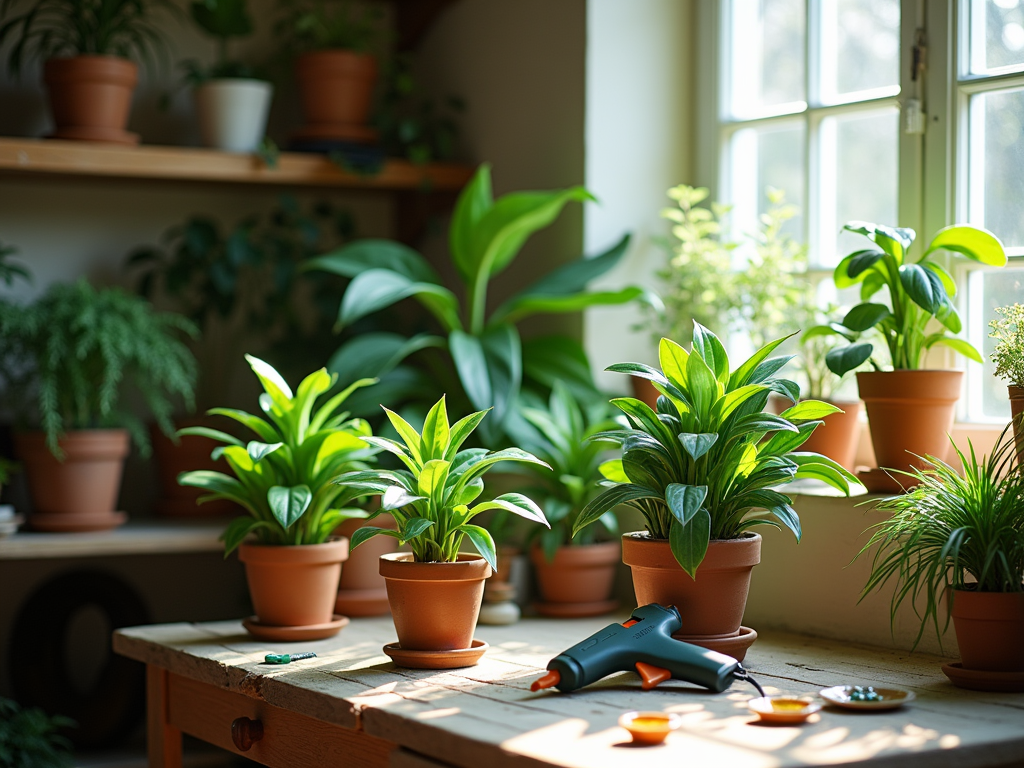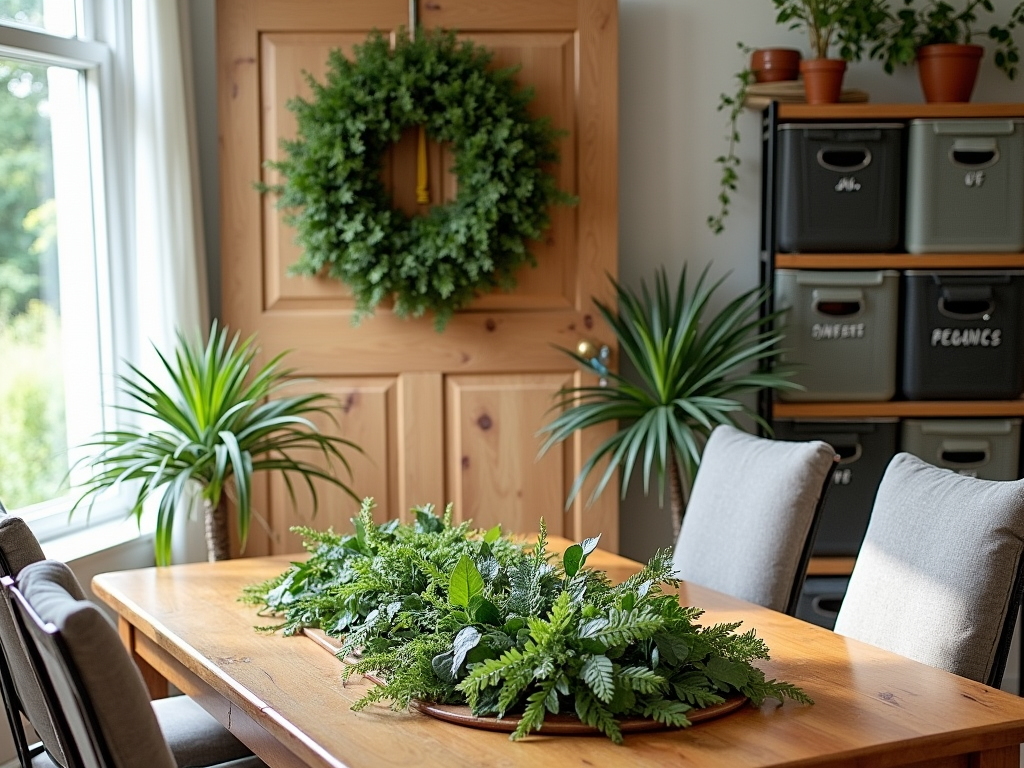
Keeping faux plants clean doesn’t just refresh their appearance—it also extends their life and ensures they stay a seamless part of your decor. Dust and grime can gather in corners and crevices, making them look dull, so regular care is essential.
Key Takeaways:
- Clean consistently to protect the plant’s colors and textures from fading or damage.
- Materials like silk need a gentler approach, while plastic can handle more hands-on cleaning techniques.
- Tools such as microfiber cloths catch and remove dust effectively, while salt can be surprisingly useful for loosening stubborn dirt in tight spaces.
- For plants that can handle water, a mild soap solution works wonders. Just make sure they’re thoroughly dried afterward to prevent any hidden moisture issues.
- A light coating of shine spray or a dab of natural oil on plastic plants creates a lifelike finish that makes all the difference.
Why Regular Cleaning Keeps Your Faux Plants Looking New
Dust and dirt build up faster than you think, clinging to the synthetic materials of faux plants. This accumulation dulls colors and makes even high-quality faux plants appear neglected. Regular cleaning not only restores their vibrant look but also helps maintain their original texture.
Freshly cleaned faux plants do more than just decorate—they brighten your space and uplift your spirits. A clean plant arrangement can offer a visual boost, especially during seasonal changes. In winter, they add a pop of greenery to combat the gloom, while in spring, they seamlessly complement nature’s rebirth.
To keep your plants looking their best, focus on consistent faux plant maintenance. It’s simpler than it sounds. Here’s why it matters:
- Combat Dust Accumulation: A monthly wipe-down or dusting ensures your plants remain lively and polished.
- Enhance Home Decor: Clean faux greenery looks just as impressive as the real thing, blending effortlessly into any decorating style.
- Boost Your Mood: Surprising as it might be, research shows that exposure to aesthetically pleasing interiors can improve mental well-being.
Adding plant care to your routine keeps your faux plants from becoming an afterthought. Treat it as an investment in keeping your home looking thoughtfully styled all year long.

Know the Materials: The Secret to Safe Cleaning
Not all faux plants are created from the same materials, so the way you clean them should depend on what they’re made of. Plastic leaves, for instance, are pretty sturdy and can handle a bit of water and soap. But silk flowers? They’re fragile and need extra care to keep them from fraying or fading.
Here’s a quick rundown of common faux plant materials and how to clean each:
Cleaning Plastic Leaves and Bases
Plastic is durable, which makes it the easiest material to clean. A damp microfiber cloth works wonders to remove dust. For a deeper clean, rinse the leaves with mild soapy water, then pat them dry to avoid water spots.
Caring for Silk Flowers
Silk flowers are beautiful but delicate. Dust them regularly using a soft brush or a blow dryer on a low, cool setting. If they’re particularly grimy, a little cornstarch or dry cleaning powder can help; dust it on, then gently brush it off.
Grapevine or Styrofoam Bases
Grapevine bases are sturdier and can be wiped off with a dry cloth. Meanwhile, styrofoam bases are more vulnerable; avoid water and stick to a dusting cloth or a vacuum with a soft brush attachment to keep them looking their best.
Identifying the materials in your artificial plants is key. This simple step ensures you’re not accidentally damaging something while trying to spruce it up.
Quick Cleaning Methods for Every Faux Plant
A microfiber cloth or a soft duster is perfect for whisking away light dust that settles on faux plants. Keep the strokes gentle, especially for more delicate greens. If there’s stubborn dirt clinging to the surface, use a slightly damp cloth instead. It cuts through grime without soaking the material.
For silk flowers, the salt technique works exceptionally well. Place them inside a bag filled with salt or cornmeal, then give it a gentle shake. This quick trick helps dislodge dust buried in intricate patterns. Afterward, make sure to brush off any remaining residue.
Grimy or stained spots need an extra touch. A solution made of equal parts white vinegar and water will often do the trick. Dab onto the affected area using a soft cloth, but always start on a hidden section first to check how the material reacts.

Soap and Suds: Deep Cleaning Made Simple
If your faux plants are water-safe, soapy water is your best friend for a deep clean. I like to use a few drops of a dish soap like Mrs. Meyer’s Lemon Verbena—cleaning is always more enjoyable with a fresh, seasonal scent in the air. Mix the soap with lukewarm water in a bowl or bucket, depending on the size of your plant.
Dip a soft cloth into the soapy water and gently scrub each surface. Focus on dusty leaves or petals, but go easy on any delicate parts. Be extra cautious if your plant has a clay or styrofoam base—those materials don’t handle moisture well and could completely fall apart if soaked.
Once every spot looks clean, give the plant a quick rinse with cold water. You don’t want to leave any soap residue behind. Just make sure the rinse isn’t too aggressive. Afterward, let the plant drip dry naturally. Shake off any excess water first to avoid water spots turning up after it dries.
This process not only restores the “just bought” freshness but also preserves the quality of your faux plant. A little soap and care can go a long way—so don’t hesitate to show your greenery some love, even if it’s the permanent kind.
Finishing Touches for a Polished Look
After cleaning your faux plants, allow them to air-dry completely. Damp surfaces can lead to odors or mold, so don’t rush this step. Be patient and check that there’s no trapped moisture on leaves or crevices before moving on.
If you spot any loose or damaged pieces, a dab of hot glue works wonders to reattach leaves or flowers securely. It’s quick, and once dried, the repair will be virtually invisible. Just make sure to remove any excess glue strands for a cleaner finish.
To give your faux plants a vibrant, lifelike appearance, consider adding a touch of shine to larger, plastic-style leaves. A silk plant cleaner spray can lightly mist the surface, revitalizing its color. Alternatively, rub a tiny drop of olive oil on your fingertips and gently smooth it over the leaves. This simple trick creates a natural sheen without feeling tacky.
However, take it easy with oils or sprays. If overdone, they can leave a sticky residue that attracts dust, undoing all your hard work. A little goes a long way—your goal is a subtle gloss, not a wet look.
Once finished, step back and admire your refreshed, realistic faux plants. It’s amazing how much brighter and more polished they’ll look with just a few small touches.

Seasonal Styling and Long-Term Maintenance
Freshly cleaned faux plants can instantly elevate your seasonal decor. They’re perfect for DIY projects like creating a mixed moss grapevine wreath or crafting leafy placemats that bring festive charm to your home. Rotate these plants with the seasons to keep your space fresh and stylish.
To keep them looking new and prolong their lifespan, dust them regularly—either weekly or monthly depending on their location. Regular light cleaning reduces the need for more labor-intensive efforts.
When you’re not decorating year-round, store faux plants in covered containers or bags to prevent dust from collecting. This small step preserves their vibrancy and makes setup easier when you’re ready to showcase them again.

Sources:
Lora Bloomquist: How to Easily Clean Artificial Plants
Living Spaces: How To Clean Artificial Plants
Disclosure: As an Amazon Associate, I earn from qualifying purchases.
